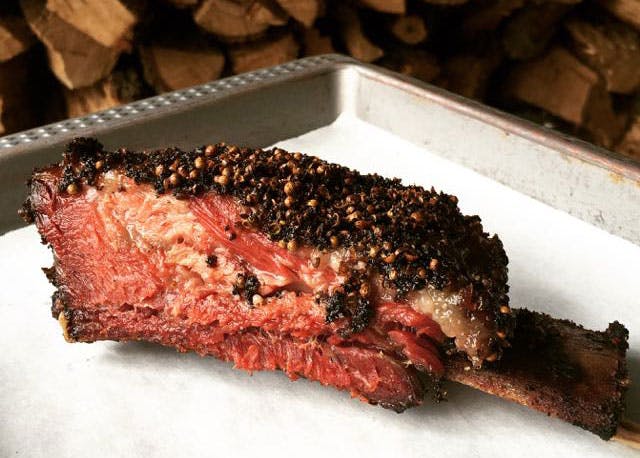
Good news, Texans: You don’t need to fly to New York for the best pastrami in the country. The bad news is that it’s only available once a week. The Granary in San Antonio starts slicing it when their doors open at 11:00 in the morning on Fridays, and it’s gone before the lunch hour ends. Hurry. It’s not too late to change your lunch plans.
The Granary has been known for their barbecue (it’s a Texas Monthly Top 50 joint) since brothers Tim and Alex Rattray opened it in 2012. Within the first month, their house-made pastrami was on the specials board and it never came off. An uncomfortable saltiness marred early offerings, but the current version became my favorite pastrami after the first bite. It was a bite so profound that it kicked off a tour of the great pastrami houses in the country to see if I could find one to match it. Some were close, but the Granary reigns supreme.
New York is the pastrami OG, but this once-a-week version in San Antonio is everything that most New York pastramis are not. In New York they use beef bellies that are smoked then steamed to doneness. The finished pastrami is sliced thin, sometimes with a deli slicer, but even when it’s done by hand it’s on the thin side. Thick or thin, it’s usually the quantity of pastrami piled high between slices of rye that is praised rather than the quality of the meat.
At the Granary, it’s all about the beef. They start with whole briskets from 44 Farms (they also make a mean pastrami beef rib). The briskets are cured for five days in a brine, then hung to dry for at least a few hours after being removed from the brine. Chef Tim Rattray explained the importance of the drying process. “You’re trying to get a pellicle. That helps the spice rub to adhere.” The rub is simply coriander and black pepper, which are toasted then lightly ground. Chunks of both spices cling to the surface of each slice.
This pastrami is smoky too. Rattray says he doesn’t bother wrapping the meat as it sits in his Oyler smoker. “The brisket is in the elements unwrapped from start to finish.” He also eschews the idea of steaming the meat, though the process makes it easier keep the meat juicy. “My understanding of the history of pastrami is that it’s short smoked and steam finished,” he says. “When I was doing the briskets I tried them the whole way on the pit, and it came out great.”
The meat is sliced thick, leaving a beautiful jet-black exterior and plenty of fat. I’ll admit readily that my penchant for traditional Texas sliced brisket partly fuels my obsession with this particular cured meat; besides the fact that it’s pink, the Granary’s brisket pastrami is hard to distinguish from great Texas barbecue, which is why it’s my favorite. The thick slices say something about the confidence the carver has in the meat’s tenderness. The subtle briny flavor cuts through the fattiness, while never rising above the well-developed smokiness. It is the perfect slice of barbecue that just happened to also be cured prior to smoking.
For now, Rattray and sous chef Matt Coogan only smoke four briskets for Friday, but hopefully they have room to up their production. With five days required in the brine, there’s still time to get a few more pastrami briskets trimmed and soaking for next week so even more hungry diners can experience the country’s best pastrami.







